

- W. Scott Howard
- "windblown leaves": acousmatic architectures & synesthetic soundscapes in Susan Howe’s Concordance
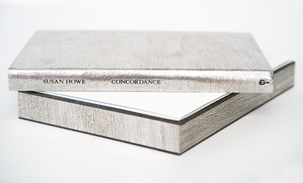
Leslie Miller’s Grenfell Press edition of Susan Howe’s Concordance and the companion chapbook, “Envoi” (2019). Photo credit: Nina Subin, courtesy Grenfell Press.
“O Some birds are more silvery-”
Susan Howe, Concordance
When I first visited with the Grenfell Press artist book edition of Susan Howe’s Concordance, it was a few days prior to the World Health Organization’s 11 March 2020 declaration of the Covid-19 pandemic. Our library at the University of Denver was a refuge during that time before. On the day of my visit, two of my library faculty colleagues were there, working in our Archives & Special Collections, and I was the only person in the reading room. The deep quiet on campus and in the building was eerie. We were all anticipating imminent restrictions against in-person activities, so my limited time with this exquisite letterpress collection of Howe’s collage poems became an enchantment. As I slowly opened the book’s facing pages, the toothy Somerset and handmade Whatman papers amplified the work’s proprioceptive haptics, soundscapes, and abstract minimalist limnings of “leaf-masks / scattered over / into their own / windblown leaves” (47). Acousmatic sounds unseen dwell among these multisensory glyphs.
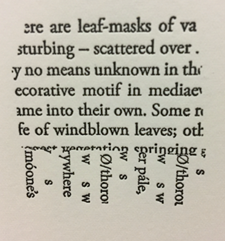
This collage poem from the Grenfell (2019) and New Directions (2020) editions of Concordance also appears as the cover image that accompanies Susan Howe’s and David Grubbs’s studio release (2021). Howe’s wordwhorls are deeply attuned to synergies among texts and trees, fabrics & folios, recalling the Latin codex (tree trunk) and textus (woven). Or, as Robert Bringhurst reminds us of an ancient metaphor: “thought is a thread, and the raconteur is a spinner of yarns—but the true storyteller, the poet, is a weaver” (25). Field guides to birds, rocks, and trees are among Howe’s numerous source texts for the “grid logic” (9) figure-ground magic in Concordance. Howe’s deftly collaged cosmopolitan communities of fonts and phonemes show us that, as Hannah Higgins notes, grids are “in a constant state of variation” that gives them “some of the animating features of living things” (10).

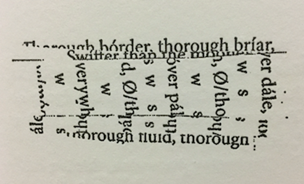
Haptic, sonic, and visual inter-/intra-textual echoes across, within, and through Howe’s palimpsestic stichomancy compose baroque choral arrangements of intermittent motifs that “wander everywhere” rabbit-like, “going on with little and great hops” (16) “Over mountain, over dale, / s w s w s w s / Thorough border, thorough briar, / s w s w s w sw / Over parking, over pale, / s w s w s w s / Thorough fluid, thorough fire, / s w s w s w s w / Swifter than the moone’s sphere […] / s w s w s w s” (45, 46, 47, 49, 52). In this instance, my transcription underscores synergies among sequential wordwhorls in Concordance (including the selected cover image from NDP p. 47 that accompanies Howe’s and Grubbs’s studio release), following just one of the innumerable collaged motifs at play in the work’s multisensory multimedia transfigurations of source materials. (I’ll return to this discussion later in this essay.)
Immersed in these synesthetic soundscapes embodied in the Grenfell Press edition, I sensed something distinctive about these new collage poems compared with Howe’s “Hannah doves” in Frolic Architecture, for example, and more kindred with her acousmatic architectures in TOM TIT TOT, which first appeared in Howe’s 2013 gallery installation at Yale Union in Portland, Oregon (for which selected pages from Frolic were arranged on one of the gallery’s walls adjacent to the tabletop open sequence of facing pages from TTT). In her remarks accompanying a 2015 exhibit of her artist books at the University of Denver, Howe reflected: “TOM TIT TOT broke my poetry, opened a new path to follow that began with the poems in Frolic Architecture and has been encouraged in acoustic directions while working on collaborations with the musician and composer, David Grubbs. I still felt somehow that Frolic was anchored-down to some material, a document or fact—to Hannah Edwards’s original text—whereas TOM TIT TOT tosses chance and discipline together in a more kaleidoscopic way.” During her lecture at Harvard Divinity School on 24 April 2019, Howe described Concordance as a “tent of paper scraps” and “a mass of quotations.”
Since the Grenfell Press edition (2019), Howe’s Concordance has indeed followed a similar journey of literary adaptations and multimedia transformations that includes a New Directions trade edition (2020), a studio recording with David Grubbs released by Blue Chopsticks (2021), and a virtual gallery installation curated by Daniel Muzyczuk and hosted by Galerie Barbara Thumm, Berlin (2022), which I’ll discuss in this essay’s concluding passages. Compared with Howe’s Frolic and TTT (both of which were first published in artist book editions from Grenfell, followed by NDP trade editions and Blue Chopsticks studio recordings), Concordance has emerged within the precariousness of Covid-19 circumstances, and those existential and technological constraints have energized the integral characteristics of what may be Howe’s most dynamic work of abstract minimalism (emerging at the intersections of texts and textiles, sonic & visual art, gallery installations, concrete poetry, typographic design, sculptural contextualisms, and bibliographic factual telepathy) that embodies the methods of her first published critical essay, “The End of Art” (1974): “to search for infinity inside simplicity will be to find simplicity alive with messages” (7). Howe’s Concordance is such a work of infinite inter-/intra-textual imbrications “transplanted […] in lists of under-shrubs / a cultivated […] coronary plant / woody: only one form.”
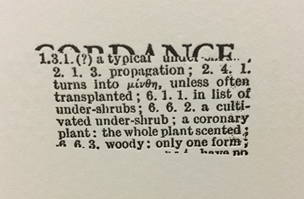
This essay offers reflections on those intersecting journeys with emphasis given to the soundscapes in Howe’s and Grubbs’s Concordance (2021), which is their fifth studio recording issued by Blue Chopsticks: THIEFTH (2005), Souls of the Labadie Tract (2007), Frolic Architecture (2011), and WOODSLIPPERCOUNTERCLATTER (2014), all of which are available via Drag City in a variety of formats, including free streaming audio excerpts. A vinyl reissue of THIEFTH (2015) was released by Issue Project Room that includes a new letterpress print by Howe (from Grenfell Press) accompanied by a hand-stamped letterpress LP sleeve. Howe’s and Grubbs’s partnership began during 2003 – 2004 at the University of Chicago, where Grubbs was working toward his PhD, which he completed in 2005. Their early collaborations were supported by an invitation from the Fondation Cartier, and so they embarked on their adaptations of Howe’s “Thorow” from Singularities (Wesleyan, 1990) and “Melville’s Marginalia” from Nonconformist’s Memorial (NDP, 1993) that culminated in their first studio release from Blue Chopsticks, THIEFTH (2005).
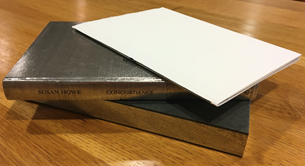
At the time of my visit to our library in March 2020, I did not know that the soundscapes of Concordance were already in motion. Howe and Grubbs began their recordings on 8 January 2020 at Firehouse 12 in New Haven, CT. Compared with their previous studio recordings (especially for THIEFTH and Souls of the Labadie Tract), Concordance is the more minimalist (although certainly not the least complex) composition, providing an intimate experience of Howe’s reading voice and Grubbs’s accompanying melodies on piano with subtle electronic remixing. (Following their January 8 recording, further recordings took place on 4 November 2020 at Oktaven Audio in Mount Vernon, NY. Those tracks were subsequently mixed by David Grubbs and Eli Crews at Spillway Sound, West Hurley, NY, and mastered by Taku Unami.) In a 2021 conversation with David Bernabo and Susan Howe (recorded via Zoom, lightly edited, then published on Medium), Grubbs reflects on their minimalist approach in Concordance, which he likens to their process with WOODSLIPPERCOUNTERCLATTER: “my decision to play the piano on this and have my contribution only be the piano really came from wanting to perform alongside in real time. [In many] of the other pieces that we’ve done, most of my contributions have been, for lack of a better term, electroacoustic sound—acoustic sounds that are processed, that I’ve gathered and composed to go with Susan’s poem [… In Concordance,] I enjoyed something other than unmuting a sample or enabling a sequence of prerecorded sounds. Just as Susan performs with her reading, I wanted to perform with an instrument.”
In this 2021 Zoom conversation with Grubbs and Bernabo, Howe describes her methods of preparing for the 2019 Grenfell edition of Concordance, assembling the collage poems via stichomancy and splicing during her visits to NYC: she would scan, print, and cut up reproduced passages from “an enormous collection of nature books from all over the world” that Howe found at a loft she was renting, as well as passages from scanned prints “from old Concordances [she had previously] found while roaming the stacks at [Yale’s] Sterling Library in New Haven [… cutting] words and bits of sentences from the xerox copies [taping] them to a page in various ways then [running] the result through a copier again.” Howe would then continue the process with Leslie Miller, scanning her “pasteups” to prepare them for high-resolution digital images, which would form the basis for the photopolymer plates that Miller would later prepare for letterpress printing at Grenfell. Howe tells Bernabo that this collaborative process of assembling palimpsestic inter-/intra-texts was “repetitive, rather rigid, but wonderful in the sense of chance and telepathy,” and likens the resulting collage poems to field recordings and watercolors.
Concordance is Howe’s fourth artist book published by The Grenfell Press, following The Nonconformist's Memorial (with six woodcuts by Robert Mangold, 1992); Frolic Architecture (with ten photograms by James Welling, 2010); and TOM TIT TOT (which was hand-printed at The Grenfell Press by Brad Ewing and Leslie Miller and published by MoMA in 2014). TOM TIT TOT is among Howe’s most collaborative letterpress volumes, and features artwork by R. H. Quaytman, the poet’s daughter. Each of these Grenfell editions subsequently appeared in a trade edition from New Directions and as a multimedia soundscape of selected and adapted passages via Howe’s and Grubbs’s studio recordings. In comparison with those previous Grenfell editions that place Howe’s poetry in dialogue with visual art, Concordance gives us 62+ pages of Howe’s linguistic prisms rotating in literal / littoral habitats plus a separate hand-sewn five-page letterpress chapbook of her poetic prose, “Envoi.” Forty-six copies of Concordance were printed on Whatman, Somerset, and Japanese Tea Chest at The Grenfell Press, and were bound by Claudia Cohen.
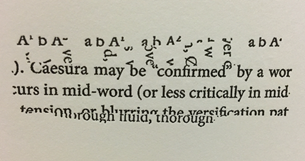
Concordance is an open work of phanopoetic polyvocal murmurations collaging “mid-word […] tension[s] or blurring[s]” of versification “thorough fluid, thorough” fire (52). The Grenfell, NDP, and Blue Chopsticks editions echo, emulate, and escape each other; their relationship is one of radical contingency and contiguity. Howe is a poet of reconfiguration; each of her works incorporates materials from earlier projects adapted anew. Her work is always changing, following converging and diverging lines of flight, asymptotes. The NDP text offers an introductory prose poem, “Since,” which elaborates upon and rearranges the letterpress chapbook, “Envoi,” that accompanies the Grenfell edition. (“Envoi” includes passages that are not to be found in the NDP edition, such as: “Are the planets visible? How blind are we to the solution of dreaming and other psychological phenomena. You are where you are steadfast tin word fortress” (np).) The NDP text then reproduces (with a few deft variations) the sequence of Howe’s “microscopic reduplications of desire […] pieced together through grid logic” (9) from the Grenfell volume and concludes with a new poem, “Space Permitting,” which collages “drafts and notes Thoreau sent to Emerson and Margaret Fuller’s friends and family in Concord, while on a mission to recover Fuller’s remains from a shipwreck off Fire Island” (NDP, back cover). (Howe and Grubbs did not adapt “Space Permitting” for their studio recordings from Concordance.)
Howe composes her poems (and her essays too) via facing page relationships; the resulting contextual synergies among her DIY collages in Concordance are sometimes trembling amidst the disjunctive interstices between the Grenfell text of [“Envoi”] and the NDP text of “Since”—“Library canary hopping on twig[.] [C]caged peeps [cheeps, pips,] scratches” (18)—and at other times playfully trenchant: “Trusting that as a helpful reader you will respond in your rabbit self. I have composed a careful and on one level truly meant narrative and on another level the Narrative of a Scissor” (15). Howe’s incisive splicings echo her audio editing days with WBAI-Pacifica (c. 1977–1981) when she produced numerous poetry programs that may be heard via PennSound
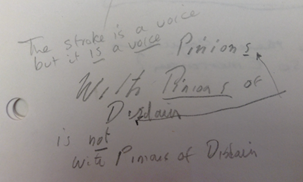
In response to Bernabo’s question, “do you consider the performance of a poem when you’re devising the poem?”, Howe offers key details about her methods at the intersections of manuscripts, typescripts, haptics, sonics, and visuals: “Every single mark that you make on paper is an acoustic mark. Every dash, the shape of letters […] I did do a lot of work on Emily Dickinson’s manuscripts for years […] But what I realized in the end […] what I actually loved was the typeface letters. It was the letters, not [the] handwriting. I can always get an acoustic thrill from the look […] There’s a kind of wild rigor. Rigor and freedom at the same time.” This astonishing reflection about her collaging process in Concordance echoes a kindred thread (220 n.380) from my conversations with Howe included in Archive and Artifact (2019) concerning her many years of dedicated attention to Dickinson’s manuscripts and how Spontaneous Particulars (2014, 2020) documents instances of that deft attunement. In those conversations, Howe noted that she also enjoys “facsimile editions of poets whose manuscripts have a strong visual component; the editorial transcriptions are of particular interest […] because they convey dogged efforts to translate into typeface what dictates the hand when it comes into contact with paper. It will always be imperfect. All the awkward typographical effects—letters, acrostic signals, strokes, cross-outs, changed meanings—can’t match the hand’s gestures, the human touch” (195). Howe’s Dickinson notebooks at the Beinecke Library document her scrupulous manuscript transcriptions, which are brimming with abbreviated epiphanies, notes, and questions, including the essential insight (see the image above, from her deciphering of Dickinson’s “With Pinions of Disdain”) that “The stroke is a voice / but it IS a voice” (220 n.380).
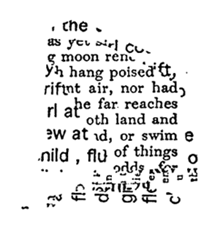
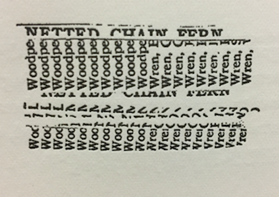
If Howe’s collage poems in Frolic Architecture are, as she says, “anchored-down” to Hannah Edwards’s manuscript, which, as Howe notes in Spontaneous Particulars (52), she could only decipher through Lucy Wetmore Whittelsey’s manuscript (that is, Hannah’s daughter’s transcription) of her mother’s Diary, then the development of Howe’s collage methods since Frolic embodies an adaptation of her acousmatic architectures and synesthetic soundscapes from manuscript to typescript stichomancy: “As a relic of the typewriter generation, my field is the page with its harmonics—something to do with breath and keys that puncture” (Concordance, 15). Whereas Howe’s origami-esque “Hannah doves” in Frolic Architecture emulate nested manuscripts ‘after’ birds in flight, her craftivist wordwhorls in Concordance have morphed into a “Flutter about peacock feather on wire,” a typographical skein of “Clefs, chirps, upward glides, falling whistles,” and a netted chain fern of “alarm calls” from woodpeckers and wrens, among many others “with mighty wings outspread / Dovelike” or “skimming Flight” (13, 19, 28, 14, 80). Compared with the emphasis given to manuscripts in Frolic, Howe describes her more recent assemblages of typographic stichomancy as “transmitting chthonic echo-signals” (Debths, 11), and as “tiptoeing on a philosophical threshold of separation and mourning for an irrevocable past holding to memory, the death of memory condensed through concordance logic lit by a hidden terrain where deepest homonyms lie” (Concordance, 25).
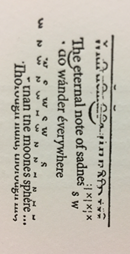
Howe and Grubbs perform their recordings for Concordance in two tracks at the intersections of glyphs, glitches, and “phonological sparks” (16) escaping “phonological nets” (27) with Grubbs on piano throughout, accompanying Howe’s hauntingly scrupulous and kinetic typographical enchantments that “wander everywhere [… Swifter] than the moone’s sphere […] Thorough fluid, thorough fire” (49). The promotional flyer from Blue Chopsticks offers a description of Howe’s and Grubbs’s collaborative process: compared with their previous studio recordings, “which feature the fragmentation and multiplication of Howe’s recorded voice—in a style akin to her celebrated text collages—with Concordance they’ve pared down their materials to voice and piano, aspiring to the hushed intensity of their live performances. After fifteen years of working together, the subtleties of inflection and interaction that previously resulted from Howe’s nuanced delivery and Grubbs’s composition using recorded materials now arrives as [an] unadorned duo performance.” Howe’s selected passages for her readings hopscotch through the figure-ground soundscapes in Concordance in the spirit of the work’s leporid allusions and puns, which include “rabbit-light” (12), “Scissor a stricken rabbit crying out” (16), and the “Rabbit-Duck illusion” (22) among others. (Howe’s longstanding fondness for such playful invocations also includes “a very deep Rabbit” (57) in Thorow.) The
Drag City website provides free access to the first of the two primary tracks from Concordance plus a third track (an excerpt); in each remediation of these studio recordings (LP, MP3, FLAC) the sequence of Howe’s selected passages varies, amplifying the manifold “EDITORIAL EMENDATIONS” (62) in Concordance’s ongoing multimedia transformations.
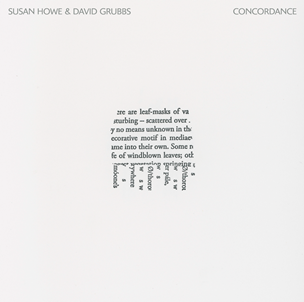
My notes here follow the sequence of Howe’s readings as recorded on the LP. In the first track (Part One, 15 minutes and 13 seconds), Howe opens with a passage from The Quarry (25), cuts to the epigraphs to Concordance, returns to The Quarry (17, 16), then follows a dazzling sequence of passages from Concordance (31–38, 14, 39, 13, 15, 40, 41, 42, 43). (For both of those intersections with The Quarry, Howe reads brief passages from “Vagrancy in the Park.”) In the second track (Part Two, 19 minutes and 46 seconds), Howe reads consistently from Concordance, opening with lines in French (44), then moving through an astonishing sequence (12, 15, 9, 16, 45–50, 52–56, 58, 59, 62, 64, 66–71, 78–83, 85, 86, 88–90). (These imperfect notes offer an outline towards what could become a more detailed visualization of Howe’s and Grubbs’s journey through these soundscapes.) These studio recordings offer innumerable moments of transport, modulating from existential meditations to indexical cross-references to ecstatic incantations remixing “Skeletal affinities, compound nonsense stutters, obsolete diphthongs, joins and ellipses, homophones, antonomasia” and “speech bubble[s]” (13) as uncanny and as various as Howe’s library of source materials.
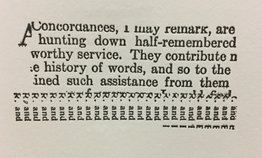
Concordance is a canopy of broken sonic slivers spliced from Howe’s “mid-word […] whispered […] Marginalia” (52, 69, 77) of allusions to and quotations from works by Epictetus, Shakespeare, Milton, Pope, Swift, Keats, Coleridge, Emerson, R. Browning, Emily Brontë, Dickinson, Arnold, Mallarmé, H. James, Yeats, Stevens, and Eliot among many others, including field guides (to birds, rocks, mushrooms, and trees), R. A. Stewart Macalister’s The Secret Languages of Ireland, the writings of Oliver Wendell Holmes Jr., and Richard L. E. Ford’s The Observer's Book of English Moths. Each page in Concordance emerges from Howe’s DIY cut & paste collaging of telepathic transcriptions, “Recovering the lost […] descending from the symbolic relation in cipher” (9, 17). Howe’s constructivist-intuitive methods collage those apposite materials—photocopying, scissoring, taping, folding unfolding over and through and over again—until the chance magic of dynamic cutting sparks regenerative “[s]epulchral Light” (39). Howe’s source materials also include a handful of concordances, including Mrs. Mary Cowden Clarke’s Complete Concordance to Shakespeare (1844–1845), Cynthia MacKenzie’s Concordance to the Letters of Emily Dickinson (2000), and Cameron Mann’s Concordance to the English Poems of George Herbert (1927) from which Howe cuts and pastes horizontal lines of text above a vertical meshing of ampersanding Rs and ands (all of which Howe enunciates precisely in the first track of her studio recordings with Grubbs).
In all of Howe’s volumes since Souls and Frolic, we encounter kinetic, helical skeins of astonishment, acousmatic architectures, and synesthetic soundscapes sparking inscape pareidolia. In the second track (Part Two) of Howe’s and Grubbs’s Concordance, one of those magical sequences happens during Howe’s reading from pages 45–50 and 52–56, beginning with the wordwhorl on page 45 that embodies lines, words, characters, and glyphs co-present in the collage poems on pages 46, 47, 49, and 52. Those five intersecting wordwhorls (except for the collage poem on page 46) have already appeared in this essay; here they are again within that sequence (45, 47, 49, 52):

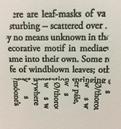


Howe’s reading from this sequence ascends “Over mountain, over dale, / s w s w s w s / Thorough border, thorough briar, / s w s w s w sw / Over parking, over pale, / s w s w s w s / Thorough fluid, thorough fire, / s w s w s w s w / I do wander everywhere / s w s w s w s / Swifter than the moone’s sphere […] / s w s w s w s,” transfigured into song by the vitalist co-presence of stichomantic source materials and their indwelling tree and forest spirits. The lilting timbre in Howe’s reading from these pages (45, 46, 47, 49, 52) underscores their importance to her and for Concordance. Howe’s collage poem on page 46 offers a key into these embedded architectures and soundscapes, where we learn from the [“first five] lines of the fairy’s answer as a good ex[ample]” […] “that the moving person is the figure a[nd the places enumerated are the ground:‘] Trajector (I, the speaker Puck [sic]) t[akes a path flying above the landmark (hill], dale, park, pale)’” (Howe, 46, [Tsur, 173]). (Puck also appears in the NDP edition as “the only person acting Connecticut [who] puts on a paper hat—Åcorn” (10), returning anew on the front cover via R. H. Quaytman’s photography and Leslie Miller’s design.)
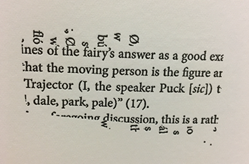
One of Howe’s source texts co-present here (and in this sequence of wordwhorls from pages 45, 46, 47, 49, 52) is Reuven Tsur’s Playing by Ear and the Tip of the Tongue (2012), which offers the culmination of Tsur’s studies since the 1970s in the field of cognitive poetics. In this instance, Tsur’s discussion of pre-categorical “emotional experiences, unique sensations, mystic insights and the like” (3) specific to poetic language turns to the Fairy’s song for Puck (aka Robin Goodfellow) in A Midsummer Night’s Dream (2.1: 2-7), the lines from which Tsur “corrupt[s] for a moment […] so as to make [Shakespeare’s verse] conform with the pattern from which the genuine lines deviate” (175). Howe’s five collage poems in pages 45, 46, 47, 49, and 52 of Concordance relay the liminal capital O with a stroke (Ø, signifying the close-mid front rounded vowel) and the diacritical apex glyphs (above some of the vowels in the Fairy’s song) directly from Tsur’s scansion.
Following neurolinguistic insights from Daniel Heller-Roazen (35-38, 139-145), we could thus entertain the possibilities that these spliced typographic refrains of smooth and rough breathers—“Ø/thorough”—transmit the phonetic spirits of the Fairy and of Puck moving through this sequence (in their forest nearby Athens); that the phanopoetic reconfigurations across these five sonicimagetexts limn a network of vitalist transcriptions and re-transcriptions; and that Howe’s stichomantic palimpsests visualize embodied articulations of sound forms in time “through concordance logic lit by a hidden terrain where deepest homonyms lie” (Concordance, 25). In a 2019 interview, when asked if typography and fonts are important for Howe’s methods, she said: “Yes, of course. They’re crucial. And the margins and spacing. My poems are like grids. The breathing spaces are so important […] something flies out of the grid. When using watercolor—perhaps because of its transparency—you can destroy an expensive piece of paper with one wrong dollop of color. But another would work like magic” (Archive and Artifact, 233). Howe’s early bird drawings and watercolors at the Beinecke Library illuminate these abiding attunements to acousmatic architectures and synesthetic soundscapes. In that 2019 interview, Howe also reflected that since her work with Pierce-Arrow (1999), she has used rainbow pencils to annotate her typescripts for readings, especially her scripts for performances and studio recordings with David Grubbs: “The rainbow effect is crucial. These odd prismatic marks—sometimes singular and clear, sometimes smudged—create a sound-sign territory of accidental purpose. I enjoy the way the colors float on the page” (205–206). Following the many birds in Concordance, Howe’s collaged murmurations alight from “Sound clusters passing through phonological nets called names but opening as if by magnet to myriad elected affinities” (27).
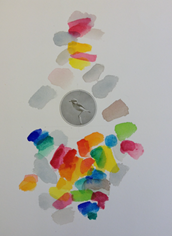
In addition to Tsur’s volume and Shakespeare’s Midsummer, some of the other stichomantic inter-/intra-texts at work in Howe’s collage poems from pages 44 through 53 include The Shakespearean Forest by Anne Barton, Matthew Arnold’s “Dover Beach,” and Anton Ehrenzweig’s Psycho-Analysis of Artistic Vision. Compared with the Grenfell Press edition of TOM TIT TOT, which provides a bibliography of Howe’s numerous source materials, Concordance relays those details through allusions & elisions, reflections & references embedded in the work’s pages and paratexts that include accompanying notations, which may be found via the Grenfell, New Directions, and Drag City websites. Howe’s methods in Concordance are as various as her palimpsests; the Grenfell Press webpage for Concordance offers an intriguing passing reference that Howe’s cut & paste assemblages were “inspired in part by the wonderful flower collages of the eighteenth-century British artist Mrs. Delany.”
The co-presence of Shakespeare’s language in so many passages in Concordance underscores Howe’s enduring fascination (especially with Hamlet, Macbeth, A Midsummer Night’s Dream, and The Tempest). During her early years, Howe acted in Shakespearean productions, and her text of The Liberties (across all of its editions) includes an adaptation of selected scenes from King Lear. Howe’s and Grubbs’s choice of the collage poem from page 47 as the cover image for their studio release amplifies these manifold Shakespearean synergies in Concordance that also include brief quotes from Emily Dickinson’s and Otis P. Lord’s correspondence concerning their shared passion for Shakespeare. Howe sounds and resounds those echoes through two of her key resources: Mrs. Mary Cowden Clarke’s Complete Concordance to Shakespeare (1844-1845), and Cynthia MacKenzie’s Concordance to the Letters of Emily Dickinson (2000). Through MacKenzie’s concordance, Howe’s Concordance documents this telling passage from Dickinson’s August 1885 letter to Judge Lord’s niece, Abbie C. Farley: “‘An envious Sliver broke’ was a passage your Uncle particularly loved in the drowning Ophelia’” (vi). Howe reads this epigraph from the NDP text of Concordance in the first track (Part One) of her studio recording with Grubbs between passages from The Quarry (as noted above). In the Grenfell Press edition, this page appears last, in the position of a pastedown endpaper preceded by a semi-opaque flyleaf, which intimates a ludic disclosure of one of the book’s animating secrets. The NDP edition places this page (without flyleaf) in the text’s front matter, which effectively translates one of the artist book’s shaping esoteric mysteries into the paperback’s exoteric homage to Dickinson’s relationship with Lord, highlighting their shared enthusiasm for Shakespeare’s plays.
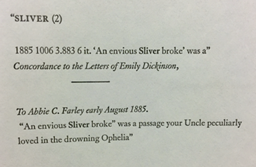
Beyond these collaged moments in Howe’s pages and recordings that echo the co-presence of Shakespeare and Dickinson, Concordance energizes countless synechistic assemblages following the legacies of kindred spirits, including Margaret Fuller, Mary “Minny” Temple, Marian “Clover” Hooper, and Fanny Dixwell (among others), whose stories intersect with Howe’s longstanding dedication to women’s rights, Transcendentalism, and nineteenth-century American women artists, educators, mystics, and reformers within contexts that also include Thoreau, Emerson, H. James, Boston literary circles, and (concerning Fanny Dixwell) shared family histories: Howe’s father clerked for Oliver Wendel Holmes, Jr., who was married to Fanny Bowditch Dixwell Holmes. Concordance also invokes a handful of early modernists (such as Jonathan Swift, Esther Johnson, Dean Delany, and Lawrence Sterne among others), and collages several inter-/intra-textual connections with the works of John Milton (14, 40, 43, 58, 64, 65, 66), shaping through those passages (and the studio recordings) some of Howe’s deepest meditations yet on Paradise Lost.
Howe’s stichomantic palimpsests throughout Concordance subvert origins and endings, engendering divinatory encounters in the spirit of her sister Fanny’s oft-cited essay from The Wedding Dress: “bewilderment is like a dream: one continually returning pause on a gyre […] the shape of the spiral that imprints itself in [the] interior before anything emerges […] For to the spiral-walker there is no plain path, no up and down, no inside or outside. But there are strange recognitions and never a conclusion” (9). Howe’s DIY cut & paste assemblages resemble Umberto Eco’s notion of open works in movement that “display an intrinsic mobility, a kaleidoscopic capacity to suggest themselves in constantly renewed aspects” (56). Indeed, Howe’s Concordance may be encountered through an ever-expanding field of the works’ swerving multifaceted manifestations: the Grenfell edition, which includes the accompanying chapbook, “Envoi”; the NDP edition, which transforms “Envoi” into “Since” and reprints all but one of the 62+ collage poems; the Blue Chopsticks studio recordings, each format of which provides a different sequence of Howe’s readings and Grubbs’s music; and via the Internet, a hyperlinked cosmos of web searches for Howe’s source texts (most of which exist in the public domain). Concerning virtual worlds, Howe acknowledges “brilliant alluring virtuosities both strange and terrible […] Faster better technologies non-real reality—'O brave new world that has [no paper] in it’,” echoing Shakespeare’s Tempest (Concordance, 15). At one moment, Howe self-identifies as a “relic of the typewriter generation” (15); and yet, in another instance, she playfully imagines a “speech bubble coming out of [the] head [of Noah Webster] contain[ing] the words, ‘I live in Divinity’” (13).
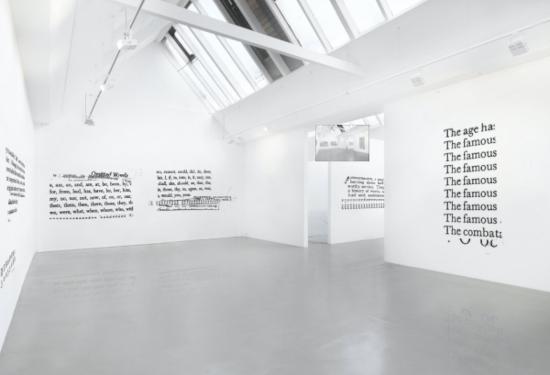
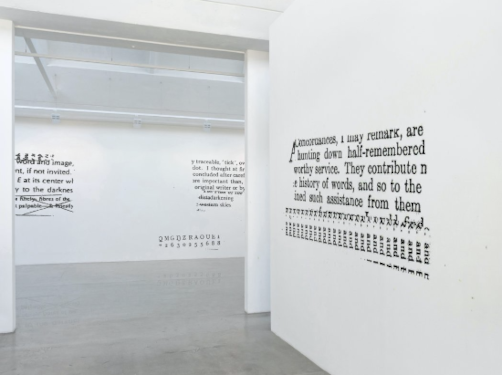
Howe’s diverse interests and nonconformist methods travel through time via multimedia. The acousmatic architectures and synesthetic soundscapes of Concordance have also appeared as a virtual installation during September 2022 in an exhibition curated by Daniel Muzyczuk and hosted by Galerie Barbara Thumm, Berlin. The virtual installation, New Viewings #36, also included works from Ivan Seal, Tomasz Kowalski, and Barbara Kinga Majewska and facilitated digital encounters during the ongoing precariousness of pandemic circumstances. In his curatorial notes, Muzyczuk reflects: “The resemblance is a matter of fidelity, but there is another thing going on in these shows. Can these objects be somehow conjured, activated? A vocal incantation places it in a narration. It is assigned with a position in time and a role within a larger performance. Mandelstam posed a seemingly absurd question: ‘What is the difference between a book and a thing?’. Can a speech bubble appear and return voice to these objects?” Muzyczuk built a virtual model of the gallery’s rooms (walls and walkways, skylight windows and track lighting, wood floors and reflections) and installed the first seven pages of collage poems from Concordance as if “the letters [would] look like [they] were pressed directly onto the walls.” Muzyczuk also included selections from Howe’s and Grubbs’s studio recordings of Concordance “so that the experience of seeing that space on the screen of the laptop or mobile phone would use something more than just images” (e-mail to wsh). Daniel Muzyczuk also curated an installation of selected pages from Howe’s TOM TIT TOT and passages from Grubbs’s book-length poem, Now that the audience is assembled (2018), at the Christine König Galerie, Vienna during October 2018. In his curatorial notes from that installation, “Speak in Order That I May See You Or Whistle And I’ll Come To You,” Muzyczuk invoked acousmatic architectures and synesthetic soundscapes as a shaping theme: “On things that are not visible and not audible […] The plea expressed in the title sets in motion a paradoxical mechanism that claims to be able to uncover the visible through the sonorous.”
When I visited with Susan Howe during January 2015 for the conversations that would eventually appear as an interview in Archive and Artifact (2019), I asked: “In recent years, your work has engaged collaboratively with digital sound and video, open-access web cultures, and galleries. How are these media—these differently charged spaces—informing or suggesting what’s next for your work?” At that time, Howe was reading (among other materials) a recent book by Brian Kane, Sound Unseen: Acousmatic Sound in Theory and Practice (2014). In reply to my question, she reflected that Kane “begins with a meditation on a mysterious noise coming from deep underground in Moodus, Connecticut. Nobody can explain its source. Scientists have offered theories, First Peoples had their explanations, settlers had theirs, current residents have theirs, but really, it’s simply unknowable. It’s a sound unseen. Like the Oracle, or the akousmatikoi and Pythagoras’s veil” (207).
From her early minimalist paintings, landscape pasteups, watercolor bird collages (c. 1965-72), and word drawings (first exhibited in 1971 at the Kornblee Gallery) to her archive of radio programs for WBAI-Pacifica (c. 1977-81) and her 35+ books of poetry and prose since Hinge Picture (Telephone Books, 1974); from her transporting studio recordings and performances with David Grubbs since 2005, residencies (Gardner Museum, 2012) and exhibitions (Yale Union 2013, Whitney Biennial 2014) to the multimedia adaptations of TOM TIT TOT and Concordance discussed in this essay, Susan Howe’s generous and collaborative spirit transfigures her materials and audiences. In December 2022, a choral performance of Howe’s “Periscope”—composed by Brendan Champeaux—was recorded at Kings Place, London. That recording, which was broadcast Christmas eve on BBC Radio 3, may be heard via the composer’s SoundCloud site.
Acknowledgments: Deepest thanks to Susan Howe for permission to include in this essay images from her Dickinson notebooks and watercolor bird collages from the Beinecke Library at Yale University. Many thanks to Daniel Muzyczuk for permission to include images from his virtual gallery installation of Concordance at Galerie Barbara Thumm, Berlin. Photographs from the Grenfell edition of Concordance appear with permission from Special Collections, University of Denver Libraries. I am grateful to my library faculty colleagues (Katherine Crowe, Peggy Keeran, and Shannon Tharp) for their support of my collection development grants dedicated to building our university’s collection of Susan Howe’s artist books. I’m especially grateful to Jonathan Minton for this essay’s appearance in Word For / Word.
Works Cited
Primary Materials:
Howe, Susan, and David Grubbs. Concordance. Chicago: Blue Chopsticks, 2021.
Howe, Susan. Concordance. New York: New Directions, 2020.
---. Concordance. New York: Grenfell Press, 2019.
---. “Concordance lecture.” Cambridge: Harvard Divinity School, 2019.
---. Debths. New York: New Directions, 2017.
---. The Quarry. New York: New Directions, 2015.
---. Spontaneous Particulars: The Telepathy of Archives. New York: New Directions, 2014.
---. Singularities. Middletown, CT: Wesleyan, 1990.
---. “The End of Art.” Archives of American Art Journal 14.4 (1974): 2- 7.
Susan Howe Papers, YCAL MSS 338, Series III, Notebooks and Diaries, 1984-2007, Box 12, Folder 24, Notebook: Dickinson Material (Spring 2001), Beinecke Library, Yale University.
Susan Howe Papers, YCAL MSS 338, Series VI, Art Work, 1958-1973, Boxes 22-30, Drawings, “Includes drawings/manuscripts done in series by Susan Howe, representing transitional works; drawings by Susan Howe, ‘Birds 71 72 Gardens 72 73?’,” Beinecke Library, Yale University.
Secondary Materials:
Bernabo, David. “Every single mark that you make on paper is an acoustic mark: an interview with Susan Howe and David Grubbs.” Medium (5 September 2021).
Bringhurst, Robert. The Elements of Typographic Style. Point Roberts, WA: Hartley & Marks, 2005.
Eco, Umberto. The Role of the Reader: Explorations in the Semiotics of Texts. Bloomington: Indiana University Press, 1979.
Heller-Roazen. Echolalias: On the Forgetting of Language. New York: Zone, 2008.
Higgins, Hannah B. The Grid Book. Cambridge: MIT, 2009.
Howard, W. Scott. Archive and Artifact: Susan Howe’s Factual Telepathy. Northfield, MA: Talisman, 2019.
Howe, Fanny. The Wedding Dress: Meditations on Word and Life. Berkeley: University of California Press, 2003.
Muzyczuk, Daniel. “New Viewings #36.” Galerie Barbara Thumm, Berlin, 2022.
---. “Speak in Order That I May See You Or Whistle And I’ll Come To You.” Christine König Galerie, Vienna, 2018.
Tsur, Reuven. Playing by Ear and the Tip of the Tongue: Precategorial Information in Poetry. Amsterdam: John Benjamins, 2012.